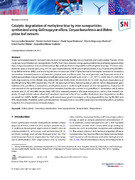| dc.description.abstract | Green synthesized metallic nanoparticles are environmentally friendly, bio-compatible, and highly stable. The aim of this
study was to synthesize iron nanoparticles (FeNPs) from FeCl3 solution using aqueous leaf extracts of Galinsoga parvifora
(Gp), Conyza bonariensis (Cb) and Bidens pilosa (Bp) and use them in degradation of methylene blue dye. The iron nanoparticles were characterized using UV–Vis spectrophotometer, FT-IR spectrophotometer, X-ray Fluorescence (EDXRF),
X-ray difractometer (XRD), and scanning electron microscope (SEM). Phytochemical screening for presence of secondary
metabolites revealed presence of phenolics, phytosterols and favonoids. The total phenolic and favonoid content in
Galinsoga parvifora, Conyza bonariensis and Bidens pilosa leaf extracts were 57.67±1.27, 117.13±0.03, 126.27±0.013 mg
Gallic Equivalent/g of Dry Weight (mg GAE/g DW) and 39.00±0.56, 45.50±0.59, 33.13±0.81 mg Rutin Equivalent/g of
Dry Weight (mg RE/g DW) respectively. The UV–Vis spectrum of FeCl3 had a shoulder at 320 nm, which disappeared upon
addition of G. parvifora, C. bonariensis and B. pilosa extracts confrming formation of iron nanoparticles. Evaluation of
iron content of the synthesized nanoparticles revealed that the iron content in G. parvifora, C. bonariensis and B. pilosa
extracts was 51, 47 and 44% respectively. XRD data revealed presence of a large amorphous coating that masked iron
peaks, though 2 theta values observed have been reported to be of iron oxides. Methylene blue degradation studies
revealed that CbNPs, BpNPs and GpNPs synthesized were good biocatalysts as they degraded the dye by 86, 84.3 and
92% respectively. Therefore, green synthesized iron nanoparticles is cost efective and environmentally safe in providing
insight in the environmental removal of dyes. | en_US |
